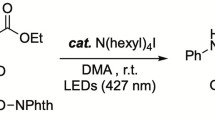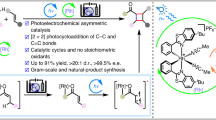Abstract
In modern industries, the aerobic oxidation of C(sp3)-H bonds to achieve the value-added conversion of hydrocarbons requires high temperatures and pressures, which significantly increases energy consumption and capital investment. The development of a light-driven strategy, even under natural sunlight and ambient air, is therefore of great significance. Here we develop a series of hetero-motif molecular junction photocatalysts containing two bifunctional motifs. With these materials, the reduction of O2 and oxidation of C(sp3)-H bonds can be effectively accomplished, thus realizing efficient aerobic oxidation of C(sp3)-H bonds in e.g., toluene and ethylbenzene. Especially for ethylbenzene oxidation reactions, excellent catalytic capacity (861 mmol g cat−1) is observed. In addition to the direct oxidation of C(sp3)-H bonds, CeBTTD-A can also be applied to other types of aerobic oxidation reactions highlighting their potential for industrial applications.
Similar content being viewed by others
Introduction
In industrial oxidation processes with a demand of >1000 tons/annum listed in Ullmann’s Encyclopedia of Industrial Chemistry, the direct oxidation of C(sp3)–H bonds using O2 as an oxidant agent accounts for a significant proportion (49 examples of 109 total examples)1,2. The obtained products have a wide range of applications in the pharmaceutical and fine chemical industriesFull size image
Transient absorption spectra (TAS) tests were performed to determine the process of photoexcitation and excited state species generation of each component in CeBTTD-A (Fig. 5b, c), which can help to analyze the transition mode of photogenerated charges. The positive excited state absorption (ESA) bands of 9-AC and negative ground-state bleaching (GSB) peak of CeBTTD-A at 550 nm can explain that the photogenerated electrons of 9-AC can quickly migrate to other motifs in CeBTTD-A (Supplementary Fig. 28). The negative stimulated emission in H4BTTD at 650 nm is weakened in CeBTTD-A, indicating that the photoelectrons from 9-AC are transferred to BTTD4−. The unchanged electron density of Ce ions determined by in situ XPS under light irradiation showed that Ce ions do not receive photoelectrons (Supplementary Fig. 29). The positive ESA bands at 1100 nm show that the lifetime of excited state 9-AC is much longer than BTTD4− and CeBTTD-A, which is in line with the analysis of kinetic processes probed at 1100 nm29,30. It also proves that the migration direction of the photoelectron is from 9-AC to BTTD4−. Density functional theory (DFT) theoretical calculations were performed to better understand the photogenerated charge separation and migration process of CeBTTD-A under illumination. As shown in Supplementary Fig. 30, the main vertical excitations of CeBTTD-A under illumination occur at 397, 412, 415, 484, and 547 nm. The attribution of the electron transition indicates that the excitation near 400 nm is mainly contributed by the transition of 9-AC itself (Supplementary Table 12), which is consistent with the absorption spectrum of 9-AC (Fig. 3a). Among them, the major contributions at 397, 412, and 484 nm are the electrons in HOMO-1 of 9-AC excited to other orbits (LUMO + 4, LUMO + 2 and LUMO + 1 respectively, Supplementary Fig. 31). It means that the hole located in HOMO-1 with higher energy than HOMO can be the major part involving the toluene C–H bond oxidation. Combined with the XAS characterization results, a reasonable photogenerated charge separation and transition process was proposed (Fig. 5d). Firstly, some electrons located in different orbits of 9-AC and BTTD motifs are excited and generate corresponding BTTD* and 9-AC* excited species under illumination. Subsequently, the excited photoelectrons of 9-AC* are transferred to BTTD*, forming 9-AC•+ and BTTD•ˉ. The photogenerated holes located in the inner orbits of 9-AC complete the oxidation of the C-H bonds, and the electrons on BTTD complete the O2-to-O2•ˉ reduction and finally achieve the oxidation of C(sp3)–H bonds.
In addition to the aerobic oxidation of C(sp3)–H bonds, we broaden our testing to other photocatalytic aerobic reactions, such as benzyl alcohol oxidation, anisole oxidation, and benzylamine oxidative coupling reactions to assess the universal applicability of CeBTTD-A. As shown in Fig. 6a–c, all these aerobic reactions demonstrated excellent photocatalytic performance and good substrate tolerance. These promising results encourage us to perform the five photocatalytic oxidation reactions mentioned in this paper in outdoor sunlight and ambient air. When the reactions were executed under real sunlight on October 10–12, 2022 (Guangzhou, China), the oxidation reactions could still be completed after 8-h illumination (Fig. 6d). Different from the results of indoor laboratory reactions, the product of the oxidation of thioanisole was mainly methyl phenyl sulfoxide, which is probably caused by the shorter duration of illumination (Fig. 6e) than indoor laboratory condition. This highly efficient photocatalytic system driven entirely by sunlight and air without any additional cost further demonstrated the advantages and commercial potential of CeBTTD-A.
CeBTTD-A catalyzed a the oxidation of benzyl alcohol derivatives, b the oxidation of thioanisole derivatives, c benzylamine derivatives coupling reaction, respectively. Reaction condition: 0.1 mmol substrates, 5 mg CeBTTD-A, 3 mL CH3CN as the reagent, 300–1100 nm xenon light source, 25.0 °C, t = trace. d The facility of photocatalytic experiments in the outdoor environment and e products yields for sunlight- and ambient air-driven aerobic oxidation reactions. Reaction condition: 0.1 mmol substrates, 5 mg CeBTTD-A, 3 mL CH3CN as the reagent, sunlight, ambient air, 8:00–16:00, Guangzhou.
In summary, we designed and developed a hetero-motif molecular junction as a model photocatalyst applied to photocatalytic aerobic oxidation of C(sp3)–H bonds. Benefited from the strong π-π interaction between the motifs in the molecular junction structure, the constructed photocatalyst CeBTTD-A can undergo rapid intermolecular migration of photogenerated charges and substrate (O2 and C(sp3)-H bonds) activation under light irradiation, so as to achieve high reactivity for oxidation of toluene and ethylbenzene derivatives. A solvent-free ten-gram-scale reaction of ethylbenzene oxidation under ambient air could be fully accomplished, which reveals better performance than other photo- or thermal-driven catalytic systems reported up to now. Apart from C(sp3)-H bond oxidation reactions, CeBTTD-A can also be applied to three other kinds of general aerobic reactions and also exhibit excellent reaction activities. More importantly, all these aerobic reactions can be driven entirely by sunlight and air without additional energy or cost input, which reveals the commercialized application prospect. We anticipate that our operating principles of hetero-motif molecular junction photocatalyst will provide inspiration to develop next-generation photocatalysts for widespread applications in constructing complex molecular blocks and break the bottleneck of sunlight- and ambient air-driven photocatalysis of more challenging reactions in an atom-economic and environment-friendly and sustainable way.






